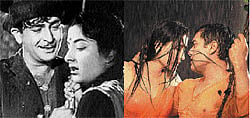
Its last appearance with a semblance of taste was the Katrina Kaif and Akshay Kumar number in De Dana Dan or Zoobi doobi featuring Kareena Kapoor and Aamir Khan in 3 Idiots. There are many films where a rain song-dance number held the viewer spellbound.
For instance, Umad ghumud kar aayi re ghata from V Shantaram’s classic Do Aankhen Barah Haath or Aaj rapat jayen to humey no bulaiyo picturised by Prakash Mehra on Smita Patil and Amitabh Bachchan in Namak Halaal. Also, very few remember Vijay Anand’s picturisation of Rimjhim ke tarane le kar aayi barsaat from Kala Bazaar, complete with the umbrella that reminds one of the Nargis-Raj Kapoor singing Pyar hua ikrar hua hai pyar se phir kyon darta hai dil in Shri 420.
From the golden black and white era to the era of films in colour, the mandatory rain song played an important role in enhancing on-screen romance. Interestingly, if the eclipse of this factor is related to the meteoric rise of Amitabh Bachchan and the kind of cinema this angry young man warranted, its return too, in many ways, should be attributed to the superstar with Aaj rapat jayen.
The best of rain songs belong to the black and white era when both the lyrics and its composition lent certain credence to romance. Two of my favourites involve the most beautiful ever heroine of Hindi cinema, Madhubala. She looked breathtakingly beautiful in Barsaat Ki Raat and Chalti Ka Naam Gadi, something that could never be emulated by any other heroine or filmmaker.
Both Zindagi bhar nahin bhulegi and Ek ladki bheegi bhagee si can also be considered as numbers that stood out in this genre. During the black and white era, aspects heightening the narrative process were the lyric and the melody. And one of the very last composers, who could bring about that effect, were R D Burman (Rimjhim rimjhim: 1942 A Love Story) and Laxmikant Pyarelal (Hai hai yeh majboori: Roti Kapada aur Makaan).
Though, the master of Hindi cinema romance, Yash Chopra, was someone who could also extract that kind of music from any composer and lines from any lyricist — lagi aaj sawan ki phir who jhadi hai in Chandni; Megha re megha tera man tarse re in Lamhe and Mere khwabon mein jo aaye in Dilwale Dulhaniya Le Jaayenge. Hindi cinema has stopped making filmmakers of that class and caliber, though Mani Ratnam’s picturisation of Barso re megha barso with Aishwarya Rai Bachchan a few years back did instill some hope that all is not over, yet.
It is not that rain songs have made an exit from Hindi cinema. If in the past they were cleverly woven into the narrative, in recent times, they look more like they are forced to produce a certain effect. Sensuousness is the casualty because the emphasis is now on overt sexuality. One of the more sensuous songs, generally been ignored by historians, is the one picturised on Akshay Kumar and Raveena Tandon from Mohra.
Sridevi, who ruled Hindi cinema in the ‘80s and ‘90s, was featured in many rain songs — Na jane kahan se aayi hai yeh ladki in Chalbaaz and Kaate nahi katte yeh din yeh raat in Mr India. But when a Kareena Kapoor sings Bhaage re mann kahin aage in a rain-soaked saree, it neither generates emotions nor sexuality.
If Manoj Kumar from the earlier crop of filmmakers used a rain song to titillate the audience in Kranti but failed, in recent times, Sudhir Mishra failed to create any impact on the audience despite the heroine’s oomph-generating physicality in Chameli. Rain songs have also been used as solo, soulful numbers. O sajna barkha bahaar layi in Bimal Roy’s lesser known Parakh or as a welcome refrain in otherwise draught situations to satiate the thirst of the parched land, like Allah megh de in Guide and Ghanan ghanan in Lagaan.
They have also been used to represent passion — Roop tera mastana from Aradhana or Baadal yun garajta hai from Betaab. And then there have been songs like Idhar chala mein udhar chala in Koi…Mil Gaya, sensitively picturised on Preity Zinta and Hrithik Roshan.
Some of the other recent notable numbers have been Zara zara from Rehna Hai Tere Dil Mein and the title song of Hum Tum starring Rani Mukherjee and Saif Ali Khan. Even Subhash Ghai’s picturisation of Taal se taal mila on Akshaye Khanna and Aishwarya Rai in Taal depicted sensuality tastefully.
However, the benchmark for rain songs continues to be Raj Kapoor’s simple and aesthetic picturisation of the duet on himself and Nargis, Pyar hua ikrar hua hai pyar se phir kyon darta hai dil in Shri 420. Its perennial appeal continues to haunt the listener even today. Raj Kapoor went on to deploy the rain song in film after film and exploited the female form to the hilt.
So if he was the master of the aesthetic, he was the grandmaster of the unaesthetic as well, as it was evident from the manner in which he used Dimple in Bobby, Zeenat Aman in Satyam Shivam Sundaram and Mandakini in Ram Teri Ganga Maili. So from Barsaat mein tak dhina din to On the roof in the rain, from Raj Kapoor to Karan Johar, welcoming of rain or romancing in the rain has continued to be a part of Hindi cinema.
But, today, it is not the song but the aesthetics, not the lyric but the poetry, not the music but the composition, that has become a casualty. Monsoon has not really disappeared from the Hindi films, but its the meaning and picturisation that has changed. It does not spell romance any more but exposure and vulgarity. Now, it has just reduced to women in bikinis. Sigh.
